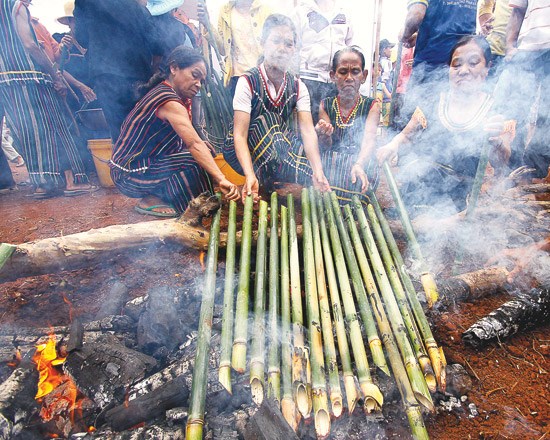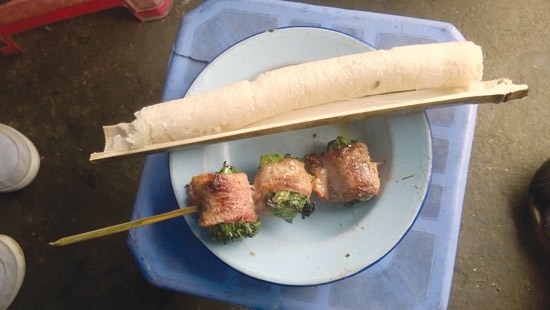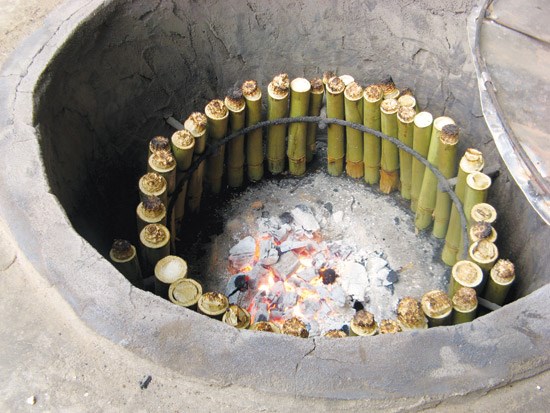Just put rice, the earth’s essence, into a bamboo tube that already has water filtered by the bamboo (heaven’s essence), and then onto a fire.
That’s
all there is the art. No one remembers when it came into the life of Muong
people. It is not only a simple kind of food, but also a feature of the unique
Muong culture.

Chong Ro people making bamboo tube rice in Dong Nai Province. Photo: Bui Viet Dong

Bamboo tube rice. Photo: Hoai Phuong
The
old ones say this is an easy-to-prepare kind of food for when Muongs are
scouting the forest with only a flint stone, a machete and a few days’ worth of
sticky rice. Just cut a section of bamboo, put some rice into it and put it on
the fire. That’s how it came into being. They found it tasty and aromatic, and
began making it at home, too. And now, coming to this mountainous region
without tasting a few chunks of bamboo tube rice, visitors would feel that
something is missing.
First,
the bamboo section should be fresh, long, not too old, and not too young. Too
old, and it will burn. Too young, it will wither and deform. The wall should be
not too thin, and not too fat. There is normally a little water inside. It
gives the rice the typical aroma that makes it appealing.
It
is the famous milpa glutinous rice that makes bamboo tube rice in Hoa Binh
Province different from that of other places. The rice is harvested during the
months of August and September. Rinsed cleanly, soaked overnight, salted
moderately, it is put into the bamboo. A little creek water is added, and the
bamboo is covered tightly with banana leaves. The tubes are stood around a fire
and turned regularly. It is normally cooked for about an hour. When the rice
feels soft at the touch, it is ready. Ms Dinh of Mo Da Village, Ha Bi Commune,
Kim Boi District, Hoa Binh Province, is famous for her bamboo tube rice. ‘The
rice has to be soft, opaque, with a buttery taste and the typical aroma of
forest bamboo,’ she said. ‘After splitting the bamboo, the rice grains have to
retain their form. To achieve this quality, the tube has to be full of rice,
and tightly shut with banana leaves. Experienced people can tell if the rice is
ready just by the smell.’
Today,
the life of the Muong people has changed significantly. Bamboo tube rice is not
only their frequent food, but also a source of income for those living around
the numerous tourist destinations of Hoa Binh Province. Ms Bui Thi Dien, a big
bamboo tube rice producer of Mo Da Village, Ha Bi Commune, Kim Boi District,
where the mineral water centre is located, told us that her family also has a
small restaurant near the centre, which sells over 200 rice tubes a day, at
VND5,000 each. They also receive orders from other food provider in the area,
from Hoa Binh city and from Hanoi. Overall, rice tubes bring her family around
VND100 million a year. Ms Dinh also said that cooking rice tubes has become an
extra trade, apart from growing rice.

Making bamboo tube rice. Photo: Ly Ha
According
to Ms Bui Thi Dung, deputy chair of the People Committee of Ha Bi Commune, Kim
Boi District, tourism has turned rice tubes into a source of income for the
people in her commune. ‘Rice tubes have helped improve the people’s lives. On
the other hand, the local government also sees that the business has to be put
under control. We have educated the people about hygiene and food safety, as
well as cultural conservation. Commercialization needs to let the rice tubes be
remaining a cultural product. Profit should not take away the cultural beauty
of the Muong bamboo tube rice,’ she said.
Rice
tubes have made their way to big restaurants in the cities. But that doesn’t
stop people from buying them in their native land, to bring home as an exotic
gift that reveals the genuine and virgin flavour of the Muong land and helps
remind urban dwellers of their own origins.
By Ly Ha/ Vietnam Heritage